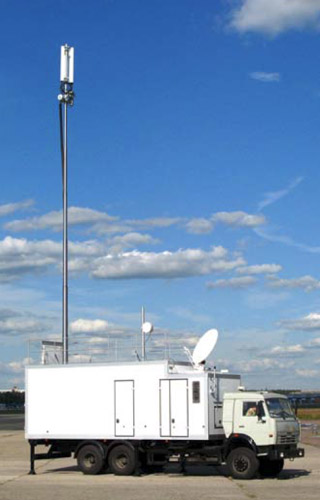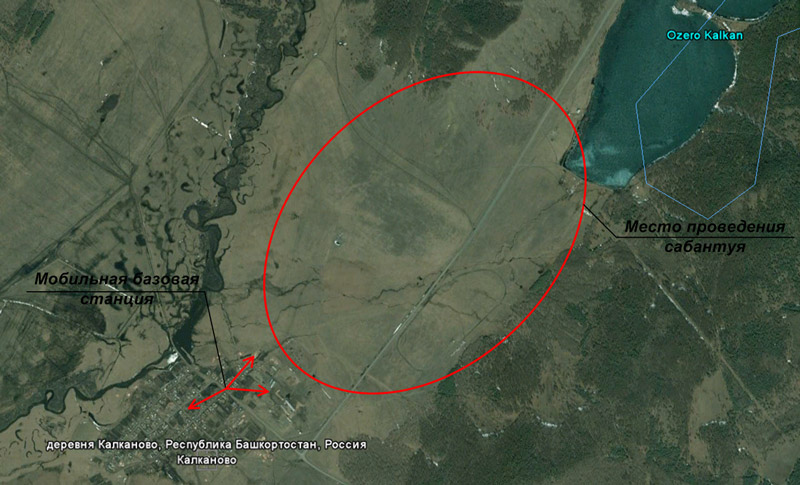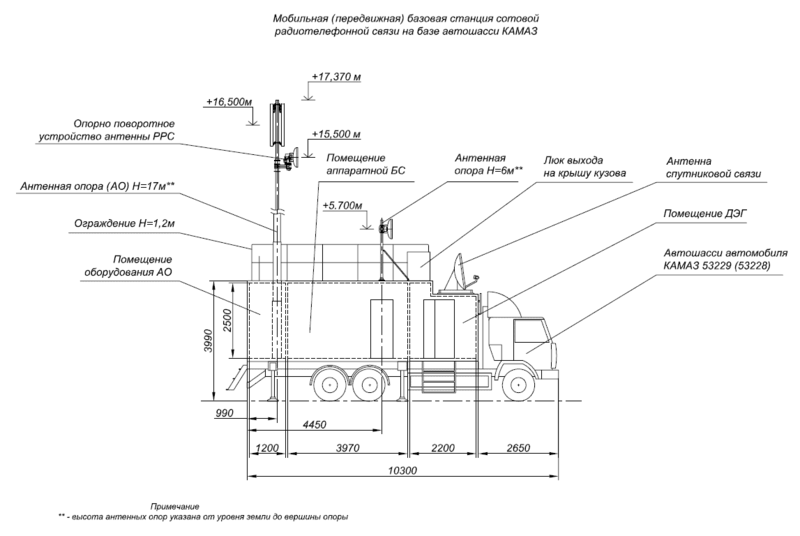Mobile base station at KAMAZ
 A mobile base station is an almost ordinary cell mounted on a car chassis and equipped with a bunch of devices to ensure work autonomy. Beeline has several such mobile stations on platforms of various payloads. They are actively used to create a coating or seal it where it is desperately needed.
A mobile base station is an almost ordinary cell mounted on a car chassis and equipped with a bunch of devices to ensure work autonomy. Beeline has several such mobile stations on platforms of various payloads. They are actively used to create a coating or seal it where it is desperately needed.What's inside the car?
- Transmitting receivers (900 MHz, 1800 MHz or 2100 MHz). Simply put, subscriber macro .
- Radio relay or satellite equipment for communication with the main infrastructure of Beeline.
- Telescopic hydraulic or collapsible antenna support, on which transceiver antennas are installed.
- The diesel generator allowing to work independently. When there is an opportunity, the station is connected to the local power grid, when there is no - it works autonomously. Four days for a small station (more often) and 12 days for KAMAZ in “autonomous” is the norm.
- Air conditioners and air heating devices to ensure the normal thermal mode for equipment and personnel (because mobile stations can operate in extreme cold and heat).
Are there any more such things?
This is the first domestic truly mobile solution. Yes, before it the equipment was installed on the machines, but it differed by a number of features, for example, a very long deployment on site. Our, thanks to the hydraulic support for the antenna, takes place in 15 minutes anywhere (large stations turn in 40-50 minutes). Now Beeline has several mobile base stations: in Moscow at KAMAZ, in the regions - on trailers.
')
Why do I need MBS?
First , for local increase in the capacity of the cellular network. Usually - at public events where you need to improve service. In this scenario, the station is able to "distribute" around itself as a normal voice coverage, and provide 3G Internet and other services.
Examples: MAKS Air Show in Moscow Region, UEFA Champions League Final at the Luzhniki Stadium in Moscow in May 2008, annual Victory Day, City Day celebrations, annual New Year mass celebrations in the amusement parks and in town squares.
Secondly , the machine can work where there is no cellular coverage and is not planned, and far enough from the operator’s infrastructure and inhabited places in general.
For example, at the site of the tragedy associated with the flooding of the Bulgari motor ship in the water area of the Kuibyshev reservoir in the Republic of Tatarstan, in Sabantui in Bashkortostan.
And more?

July 6-7, 2011 In the Uchalinsky district of the Republic of Bashkortostan there is a spring holiday (Sabantuy) in the village of Kalkanovo on the shores of Lake Kalkan. Cellular communication in the territory of the celebration is absent in all operators. The population of the village is 395 people, the approximate number of people who attended the holiday is 2000 people. Two weeks before the holiday, coordination begins, then the station leaves for a place and, within an hour, deploys and goes into a fully functional mode. The crew - two people: the driver-mechanic and engineer. They live directly in the car, where there are two beds. They eat food and dry rations “from home”, bought for “travelers”, plus they have the means to buy hot food directly at the holiday. Phase centers of antennas are at a height of 10-15 meters above the ground, therefore, at the level of the machine, the radiation density is hundreds of times lower than the permissible standard, and inside it decreases another hundred times, and lead pants are not needed. During the BS operation, the total traffic was 385.14 Erlang, and there were overloads a couple of times (1 Erlang is one hour of the subscriber’s talk on the network taking into account the dialing time, that is, the total number of subscribers talked for about 16 days in 2 days: the distribution was uneven).
How many pieces of paper you need to sign to leave the garage?
Before including MBS equipment on the air, it is necessary to calculate and then agree on the installation site, standard, range, number of radio frequencies required, antenna height with the regulator, since base stations of other operators and equipment of other departments can work at the epicenter of events. Then you need to enter data into the BS equipment and configure it so that the work of the MSS should be integrated into the existing network of the operator. Staff use involves a couple of weeks at the exit, reconnaissance and all approvals. Emergency cases - about two or three days. Theoretically, this process can be forced up to 1 day. The “instant” installation of a base station in a new place is technologically possible, but illegal, since permission is needed for frequencies: if done without it, it threatens to revoke a license.
What about specific TX?

For example, we have KamAZ-53229, where in an insulated body of a van there is an antenna with a support 17 meters high. The chassis is designed to move only on a hard surface (roads, fields, etc.), is deployed without stretch marks. On the support are 3 sector antennas with a height of 1.3 meters, a PPC antenna with a diameter of 0.6 meters. The support is equipped with a device for remote adjustment of the PPC antenna, an additional pipe rack is installed on the roof of the body for mounting the PPC antenna. The isothermal body has three compartments - the BS hardware compartment, the antenna support equipment compartment and the diesel-electric generator compartment. In the hardware compartment of the body there are 8 racks of technological equipment with a height of up to 1.9 m (BS racks, EPU with batteries, transmission systems). Compartment height
BS hardware 2.5 meters. It has a satellite earth station (PZSSS) with a 1.2-meter antenna with a automatic guidance system onboard a satellite repeater. The PZSSS provides the binding of MBS to the switching network by means of four digital streams of 2 Mb / s.
The hardware compartment of the body is equipped with air conditioning, heating and forced-air and exhaust ventilation. It has an autonomous power supply system - a 16 kW diesel-electric generator with fuel tanks. The battery life in normal mode for at least 12 days. Plus 140 meter long cables for connecting MBS to a three-phase external network
power supply. The hardware BS is equipped with the operator’s workplace, as well as two sleeping places (in the BS hardware room and the car cabin). The crew of MBS - 2 people. It is possible to use atmospheric lasers for connection, but they are not installed in the current configuration. The station is adapted for Russian conditions: resistant to heat, cold, bears and vandals.
Is the network capacity growing when deploying a number of mobile BS?
In general, yes, it grows. But, for example, if you deploy the BS in an area where the coverage has already reached the theoretical maximum in frequency distribution (the center of the metropolis, for example), only the signal level will improve, but not the number of simultaneously calling subscribers.
What's next?
Most likely, soon it will be possible to achieve greater autonomy of the base station, in particular, due to capacious batteries or alternative energy (we have stationary solar-powered base stations , for example). The second point is faster and more dense communication with the main infrastructure. Now we have already used a mobile base station on a trailer to provide video communication for the newlyweds with the registry office at a distance of 170 kilometers (this was the first wedding online in Russia) and to enable knights from the reconstruction of the Borodino battle to call their friends and parents. In the future, apparently, such situations will be much more.
Source: https://habr.com/ru/post/132643/
All Articles